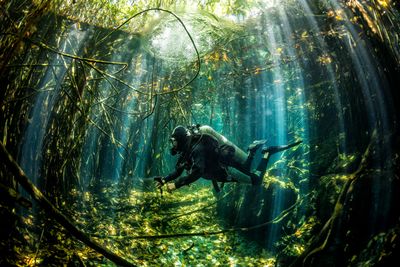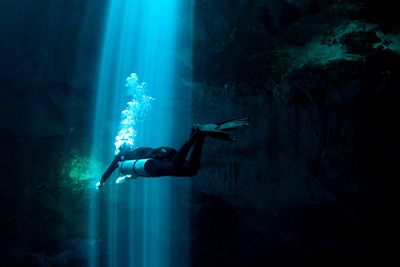Diving in Mexico's cenotes is rather different from your average dive. Formed when soft limestone collapses, cenotes are essentially sinkholes connected by a labyrinth of secret underground caverns. Why is diving them so special? Aside from the pure thrill of cave diving, the water is so clear it feels like you're flying. But with so many cenotes (there are over 7,000!), how do you pick which ones to dive? Grab your mask and prepare to dive in to our top cenotes in the Yucatan Peninsula.

Dos Ojos
Made famous by the chaps over at National Geographic, Dos Ojos (Two Eyes) is one of the largest underwater cave systems in the world, extending almost 40 miles and reaching depths of 118 metres - although it is still being explored. As the name suggests, Dos Ojos is actually two cenotes connected by an extensive system of caverns but most people dive the Blue Eye and Black Eye. Armed with a torch, you'll descend to a maximum depth of nine metres (make sure you look back at the entrance for turquoise light effects), passing through caverns lined with stalagmites and stalactites millions of years old. Mid way through the dive you will come to the bat cave, it's all rather like jaws as you eye the snorkellers thrashing around above. Once you've ascended into the bat cave and gawked at the bats you enter the second Ojo, exploring the eerie caves before circulating back to the entrance.

Casa Carwash
This cenote's name allegedly arose due to taxi drivers washing their cars there, however we much prefer to refer to this haven as the underwater garden. Possibly the prettiest cenote to dip into, this cenote is one for snorkellers and divers alike. Hidden at the side of the road that leads from Tulum to the Coba ruins, this is the perfect cenote to explore on the way back from a morning's sightseeing. Armed with a mask and snorkel, jump in and be greeted by an abundance of plant life rising from the floor. Freedive down and swim through the lily pads, watching out for the terrapins that call this cenote home (divers enter a cavern to the side of the cenote that extends to a maximum depth of 15 metres).

Angelita
Mayans considered cenotes as portals to the underworld, and descending into cenote Angelita definitely feels like you're entering another dimension as turquoise waters dissolve into an eerie green. At 30 metres a jagged island of trees emerges out of a thick Halocline cloud, the result of salt water mixing with fresh water. Below the halocline is pitch black, switch on your flashlight to reveal stalagmites and swim throughs.

Casa Cenote
This dive is slightly different from the others. Connecting one of the world's longest underwater systems to the ocean, Casa Cenote has a lot more fish life as fresh water flows out of the river system and salt water flows in from the ocean. Oh, and let's not forget about the mangrove forest overhead, allowing you the unique experience of diving below the jungle with mangrove roots as your ceiling. The maximum depth of this dive is eight metres and a large open water area also makes it a great place to learn.

The Pit
If you haven't read Original Diving expert Louisa's account of diving The Pit cenote, give it a gander now. The water is so clear you can see the entire cavern from the surface and it feels like you're sky diving as you descend (to a maximum depth of 30 metres). 13 metres down everything goes rather fuzzy as you enter the Halocline cloud. The best part, however, is just below when you look up at the entrance where shockingly blue shards of light pierce through the water like the filament in a light bulb.
Would you like to dive in the cenotes of Mexico? Get in touch and we'll help you get there!












